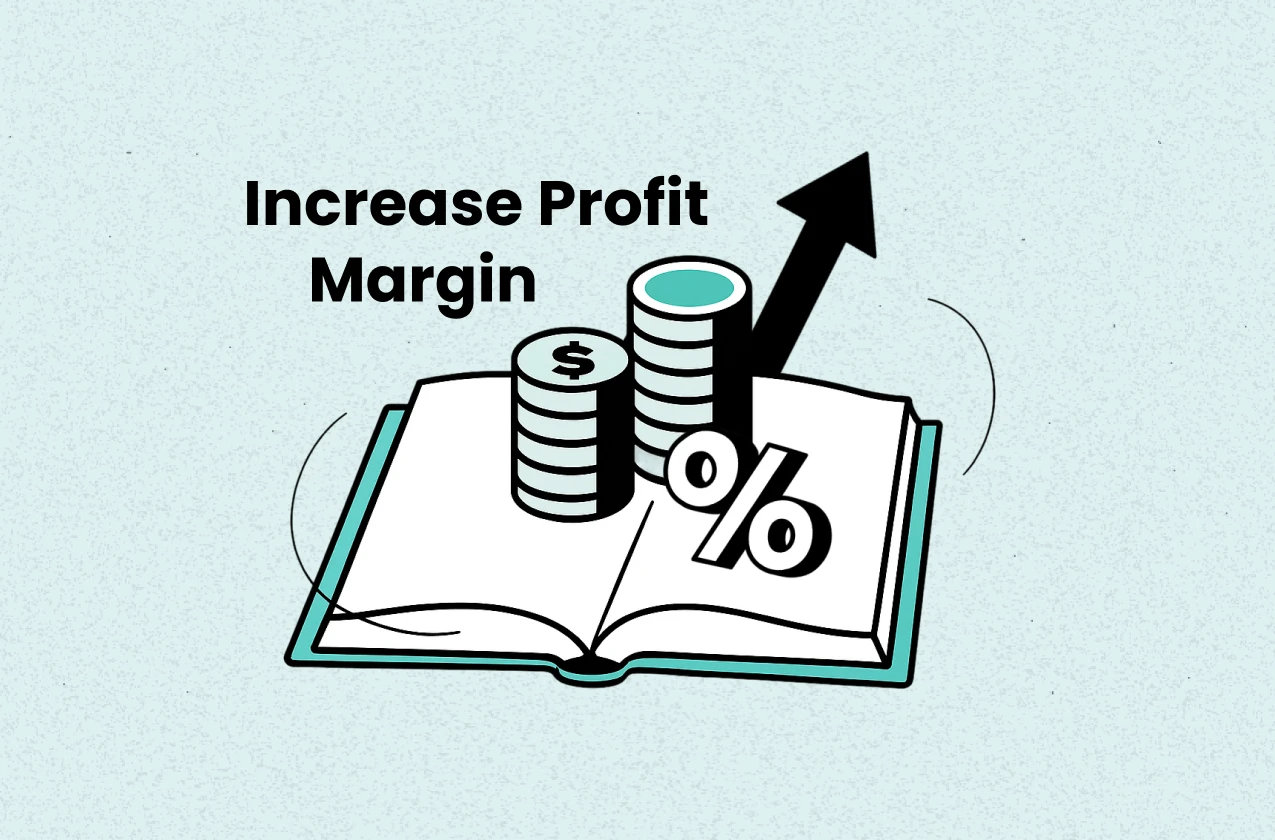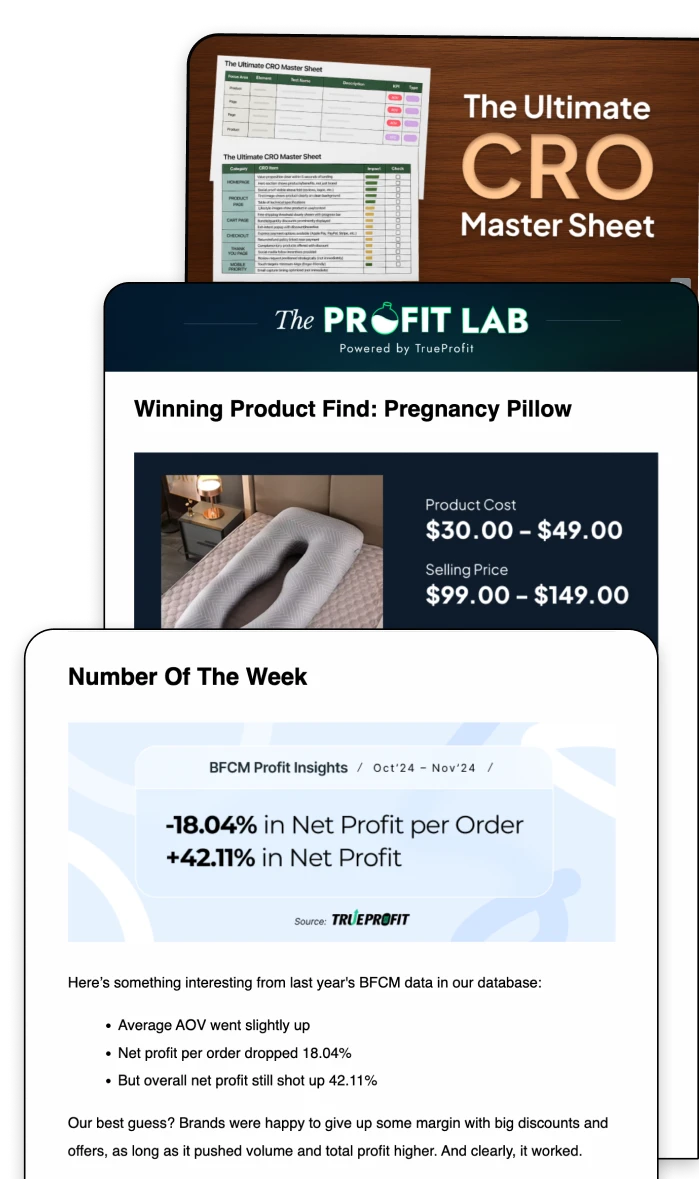7 Expert Strategies on How To Increase Profit Margin for Ecom (2025)

Profit margins can make or break your ecommerce business. Understanding how to increase profit margin is critical—not just for survival, but for growth and long-term success.
In this post, we’ll unpack the types of profit margins, what “good” looks like, actionable tactics to improve margins, and why this metric deserves your constant attention. We’ll also include expert insights, real-world examples, and answers to top questions from ecommerce sellers like you.
What Is Profit Margin?
Profit margin is the part of money a business keeps as profit from its sales after paying all its costs. It shows how much of each dollar earned is actual profit.
There are three main types of profit margin you’ll come across:
1. Gross Profit Margin
Gross profit margin is the percentage of sales money left after subtracting only the cost of making or buying the products sold. It shows how much money a business keeps from sales before paying other expenses like rent, salaries, or taxes.
To calculate gross profit margin, take your revenue, subtract the cost of goods sold, then divide that number by the total revenue. Multiply by 100 to get the final percentage.
Gross profit margin formula is:
For example, if a company earns $100,000 in sales and spends $60,000 on producing those goods, the gross margin would be:($100,000 − $60,000) ÷ $100,000 = 0.40 → 40%
Keeping track of gross profit margin helps you understand how efficiently you’re producing or sourcing your goods.
2. Operating Profit Margin
Operating profit margin is the percentage of revenue a business keeps after covering both the cost of goods sold and its operating expenses—such as rent, salaries, utilities, and other day-to-day costs. It shows how efficiently a company is running its core operations before paying interest or taxes.
To calculate operating profit margin, take your operating income (which is gross profit minus operating expenses), divide it by total revenue, and multiply by 100 to get the percentage.
Operating profit margin formula is:
For example, if a company has $25,000 in operating income on $100,000 in revenue, the operating margin would be:
$25,000 ÷ $100,000 = 0.25 → 25%
Tracking operating profit margin helps reveal how well a business is managing its ongoing costs to generate profit from regular operations.
3. Net Profit Margin (the one most people refer to)
Net profit margin is the percentage of revenue that remains as actual profit after all expenses have been deducted. This includes not only the cost of goods sold and operating expenses, but also interest, taxes, and any one-time charges. It’s often referred to as the “bottom line” and gives the clearest picture of a company’s overall profitability.
To calculate net profit margin, take your net profit (the amount left after all expenses), divide it by total revenue, and multiply by 100 to get the percentage.
Net profit margin formula is:
For example, if a company ends up with $15,000 in net profit from $100,000 in revenue, the net margin would be:
$15,000 ÷ $100,000 = 0.15 → 15%
Monitoring your net profit margin helps you understand how much of your sales income is ultimately turning into profit—after everything is paid.
Why Tracking Profit Margins Matter?
Tracking profit margins matters because it helps you understand how efficiently your business is turning sales into actual profit. Each type of margin—gross, operating, and net—offers insight into different parts of your cost structure, from production to overhead to final earnings.
By monitoring these margins regularly, you can spot rising costs, identify areas to improve efficiency, and make smarter pricing or budgeting decisions.
Profit margins also make it easier to compare your performance over time or against competitors, giving you a clearer picture of financial health and long-term sustainability.
What Is a Good Profit Margin?
There’s no one-size-fits-all answer, but these benchmarks provide guidance:
1. What is a good net profit margin?
- Industry Average: According to Shopify and the NYU Stern School of Business, most healthy ecommerce stores have a net profit margin of 5–10%. Top performers exceed 15–20%.
- Interpretation: If your margin is below 5%, your business model may need tweaks to ensure long-term viability.
2. What is a good gross profit margin?
- Typical Range: 20–40% is common for ecommerce, though it can be higher for direct-to-consumer (DTC) brands or niche products.
- Interpretation: If you source premium products or have high COGS, gross margins may be lower; if you create your own products or source overseas, you may achieve higher margins.
3. What is a good operating margin?
- Healthy Range: 10–20% is solid for most ecommerce businesses.
How to Increase Profit Margin?
When it comes to improving profit margins for your eCommerce store, your options are essentially limited to two: earning more or spending less.
1. Increasing Revenue
Optimize Your Pricing Strategy
One of the most effective ways to increase your profit margin is to refine your pricing approach. For instance, luxury skincare brand Glossier uses value-based pricing—charging not just based on production cost, but on the perceived lifestyle and aesthetic value of the product.
Similarly, many Shopify merchants successfully bundle products (like a t-shirt, cap, and tote bag) and offer them at a slight discount, which increases average order value while improving overall margins. Small price increases—like raising a $20 product to $22—can boost profit without impacting sales volume when done thoughtfully.
Increase Average Order Value (AOV)
Getting each customer to spend more per order is a direct route to improving profit margins. A common strategy is the “Buy More, Save More” model used by brands like Gymshark, where customers get increasing discounts as they add more to their cart.
Similarly, beauty brands like Fenty Beauty suggest add-on products (e.g., matching lip liner when buying lipstick) right at checkout, increasing AOV with minimal extra cost. Offering free shipping on orders over a certain amount—for example, “Free shipping on $75+”—is another powerful motivator that also boosts your average basket size.
Focus on Customer Retention
Acquiring a new customer can cost 5–10 times more than keeping an existing one, so retention has a major impact on profitability. Sephora’s Beauty Insider loyalty program is a great example—it encourages repeat purchases with exclusive rewards and personalized offers.
Smaller businesses often succeed with targeted email marketing using tools like Klaviyo, sending product recommendations or birthday discounts to past customers. The better your customer experience (fast delivery, easy returns, great support), the more likely buyers are to come back—boosting your long-term profit margins without increasing ad spend.
Refine Your Marketing Strategy
Poorly performing ads can eat into profits fast, so it's essential to invest in what works and cut what doesn’t. Direct-to-consumer brand Blenders Eyewear increased profit margins by focusing on retargeting warm leads—like cart abandoners—through Facebook and Google Ads instead of constantly chasing new traffic.
Meanwhile, many eCommerce founders have found great success creating SEO-rich blog content and YouTube videos that draw in free organic traffic over time. These content strategies, while slower to build, have a much lower cost per acquisition compared to paid ads and help margins stay healthy.
2. Reducing Costs
Reduce Product and Fulfillment Costs
Lowering the cost of goods and logistics can directly improve your margins.
Take Allbirds, the sustainable shoe company—they initially struggled with high production costs but improved margins by scaling up orders with suppliers and optimizing their shipping processes.
Smaller eCommerce businesses can do the same by renegotiating supplier contracts or switching to domestic manufacturers to reduce shipping delays and costs.
Also, exploring 3PL solutions like ShipBob or Deliverr can help streamline fulfillment, especially if you’re selling across multiple channels like Amazon and your own website.
Improve Operational Efficiency
Automating repetitive tasks and cutting out waste in operations protects your profits. For example, MVMT Watches used automation tools for email flows and inventory alerts to cut down on manual labor as their business scaled. Many Shopify store owners use apps like Inventory Planner or Gorgias to manage stock and customer service more efficiently.
Reducing return rates is another key step—clothing brands like ASOS use detailed sizing guides and augmented reality fitting tools to help customers make the right choice the first time, saving on return shipping and restocking.
Track Your Profit Margins Accurately and in Real Time
Without accurate and timely data, it’s impossible to make smart financial decisions. Brands like Casper and Brooklinen use real-time dashboards to monitor not just sales, but also key profit indicators like cost per acquisition, shipping cost per order, and gross margin per SKU.
For Shopify merchants seeking the most accurate and real-time insight—especially when it comes to net profit margin—TrueProfit stands out as the best option.
TrueProfit is a Shopify Net Profit Analytics platform that automatically pulls in sales, advertising, product, shipping, and handling costs, giving you a real-time, comprehensive view of your actual profit and loss at both the store-wide and down to ad level and SKU level.
Unlike other tools such as Lifetimely or BeProfit, which may focus on surface-level metrics or don’t fully calculate true net profit, TrueProfit provides instant updates and clear reporting, making it easy for you to spot margin leaks, respond quickly, and protect your bottom line.
The app offers 14-day free trial and the basic plan starts at only $30/ month.
Why Is Tracking and Improving Profit Margin Important?
High sales alone don’t guarantee profitability—a store making $1,000,000 in revenue can still lose money if margins are thin and costs aren’t well managed.
Strong profit margins are crucial because they provide growth capital, allowing you to invest more confidently in inventory, marketing, or hiring as you scale your business.
In times of economic uncertainty, healthy margins act as a financial cushion, helping your store absorb drops in demand or rising supplier costs.
Finally, if you ever plan to sell your business—as many Shopify brands eventually do—robust profit margins will significantly enhance your company’s valuation and attract serious buyers or investors.
Benefits of Improving Profit Margin
- Sustainable Growth: Cash left over gives you freedom to test new marketing channels, launch products, or expand globally.
- Operational Stability: Better margins mean salary, rent, and supplier bills are paid without stress—even in slow months.
- Brand Differentiation: With higher profit, you can afford better service, support, or perks (like faster shipping) that competitors can’t match.
- Attract Investment: Investors look for efficient, profitable ecommerce models—higher margins shorten due diligence and command higher multiples.
Looking to boost your bottom line? This post breaks down practical strategies on how to increase profit margin by optimizing pricing, reducing costs, and focusing on high-value offerings.
Whether you're a small business owner or managing a larger operation, these tips will help you expand margins and grow profitability.
Irene Le is the Content Manager at TrueProfit, specializing in crafting insightful, data-driven content to help eCommerce merchants scale profitably. With over 5 years of experience in content creation and growth strategy for the eCommerce industry, she is dedicated to producing high-value, actionable content that empowers merchants to make informed financial decisions.





 Shopify profits
Shopify profits

